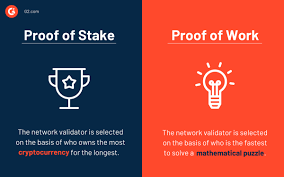Next-Generation Consensus Mechanisms: From Proof-of-Work to Proof-of-Stake and Beyond
Introduction
Blockchain technology has become one of the most disruptive innovations of the 21st century, powering cryptocurrencies, decentralized applications (dApps) and digital ecosystems. The center of any blockchain has a consensus mechanism, a protocol that determines how participants agree on the state of the ledger. Without credible consensus mechanisms, blockchains would suffer fraud, manipulation and failure.
The oldest and most famous method, proof of work (PoW), was introduced by bitcoin. Although efficient, PoW comes with challenges such as high energy consumption and limited scalability. This has pushed the blockchain industry towards exploring proof-of-stake (PoS) and new mechanisms such as delegated proof-of-stake (DPoS), proof-of-authority (PoA), proof-of-history (PoH), and hybrid models. These innovations aim to balance security, decentralization and scalability often referred to as “blockchain trilema”. ”
In this article, we will dive deeper into the evolution of consensus mechanisms, analyzing their strengths, weaknesses and future potential impacts.
Understanding the consensus in the blockchain
Consensus mechanisms are important because blockchains operate in a decentralized environment without central authority . Participants (nodes) must agree on the validity of the transaction and the order in which they occur.
In traditional systems, banks and institutions validate transactions by ensuring trust.
In the blockchain, this trust is replaced by cryptography and consensus algorithms.
The correct consensus mechanism ensures that malicious actors cannot manipulate the network while allowing legitimate transactions to be processed efficiently .
Proof of work (PoW): Foundation

How PoW works
Proof of work, introduced by Wikipedia in 2009, requires miners to solve complex mathematical puzzles to validate transactions and add blocks to the chain. This process, called” mining”, endows successful miners with cryptocurrency.
The power of a prisoner of war
Security: highly resistant to attacks due to the need for massive computational power.
Proven track record: bitcoin and Ethereum (prior to the merger) successfully operated for years under PoW.
The weaknesses of PoW
Energy consumption: mining requires a lot of electricity, raising environmental concerns.
Centralization risk: mining power is often concentrated in areas with cheap energy.
Scalability issues: the speed of transactions is limited, and fees can increase during congestion.
Proof of Stack (PoS): energy-efficient alternative
How PoS works
Unlike PoW, stake evidence eliminates energy-intensive mining . Instead, validators they are selected to generate new blocks based on the amount of” stakes ” cryptocurrency (locking as suicide). The higher the stakes, the higher the chance of being elected.
Benefits of PoS
Energy efficiency: mass computational power is not required.
Scalability: fast transaction throughput and low fees.
Incentive alignment: validators risk losing their stakes assets if they act in bad faith.
The challenges of POS
Wealth concentration: large stakeholders have greater impact, which can lead to centralization.
Nothing at stake problem: validators can validate a number of competing chains without penalty (although harvesting procedures address this).
Ethereum’s transition to POS through Ethereum 2.0 (integration) in 2022 highlighted the industry’s shift towards sustainable models.
Proof of stake (DPoS )
How DPoS works
DPOs introduces a democratic element where token holders vote for a limited number of Delegates or validators who secure the network. Popular blockchains such as Eos and TRON use DPoS.
Power
High performance: supports thousands of transactions per second (TPS).
Democratic governance: token holders actively participate through voting .
Weaknesses
Centralization: only a small group of Delegates control the network.
The threat of collusion: validators can form alliances, undermine justice.
Proof of authority (PoA )
In the authority of evidence, validators are selected based on their credibility and identity rather than tokens or computational power. This method is often used in private or consortium blockchains, where trust is established in participants.
Pros: fast, efficient, and low cost.
Cons: not completely decentralized, as it relies on reliable validators .
Proof of history (PoH) and Solana’s innovation
Solana introduces proof of history (Poh), which uses encryption timestamps to prove the order of events before they are verified by the verifiers.
Advantage: extremely fast processing, enabling Solana to handle more than 50,000 TPS.
Breakdown: high technical complexity and risk of network outages, as seen in Solana’s early years.
Hybrid consensus model
Many blockchains now combine multiple mechanisms to achieve balance. For example:
Ethereum 2.0 combines pos with shard chains .
Polkadot uses nominal evidence acquisition (NPO).
Cosmos uses tenderment BFT mixing POS with Byzantine Fault Tolerance
These hybrid models are designed to maximize decentralization, scalability and security.
Comparison of different consensus mechanisms
Mechanism energy use decentralized speed security examples
Proof of work (PoW) very high medium low very strong bitcoin
Proof – of-stakes (PoS) low-high (with risks) High-strong Ethereum, Cardano
Assigned PoS (DPoS) low medium very high medium EOS, TRON
Proof of authority (PoA) very low low High strong (private) VeChain
Proof of history (PoH) medium, high, very high, strong Solana
Blockchain trilema: security, scalability , and decentralization
The biggest challenge to a consensus mechanism is solving blockchain trilema . :

Security-protecting against attacks.
Scalability-handling large volumes of transactions.
Decentralization – ensuring that no party controls the network .
Different mechanisms prefer one or two aspects but struggle to achieve all three. For example:
PoW prefers security and decentralization but struggles with scalability.
DPOs prefer scalability but threaten centralization.
Hybrid models try to balance all three .
The future of consensus mechanisms
The future will likely involve continuous innovation, with new models designed to address vulnerabilities in existing systems. Key trends include:
Green consensus: mechanisms that minimize energy consumption .
Quantum-resistant protocol: protecting the blockchain from future quantum computing threats.
AI-improved consensus: using machine learning to predict malicious activity and improve network performance.
Multi-layer solutions: combining Layer-1 consensus with Layer-2 Scaling (e.g., rollups, side chains).
Result
Consensus mechanisms are the heartbeat of blockchain technology, ensuring that decentralized systems remain safe, efficient and reliable . From evidence of bitcoin’s work to emerging models such as proof of Ethereum’s stakes and evidence of history, each method reflects efforts to balance industry security, decentralization and scalability.
The journey does not stop here. As the adoption of the blockchain progresses across finance, supply chains, gaming and beyond, next-generation consensus mechanisms will determine the future of digital trusts. Whether through hybrid models, AI integration, or entirely new innovations, consensus will continue to evolve to meet the demands of a decentralized world .





